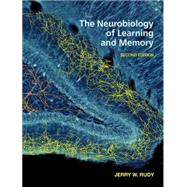The Neurobiology of Learning and Memory

The Neurobiology of Learning and Memory
- ISBN 13:
9781605359342
- ISBN 10:
1605359343
- Edition: 3rd
- Format: Hardcover
- Copyright: 07/31/2020
- Publisher: Sinauer Associates is an imprint of Oxford University Press
.svg) Rent
From $114.04
Rent
From $114.04
List Price $191.98 Save
| TERM | PRICE | DUE |
|---|---|---|



List Price $191.98 Save $1.92
Usually Ships in 3-5 Business Days
We Buy This Book Back!
Free Shipping On Every Order
Note: Supplemental materials are not guaranteed with Rental or Used book purchases.
Extend or Purchase Your Rental at Any Time
Need to keep your rental past your due date? At any time before your due date you can extend or purchase your rental through your account.
Summary
Part One explores the molecular basis of the synaptic changes that support memory. It begins with an overview of memory from the perspective of the brain. It next describes the long-term potentiation methodology used to study how synapses are modified and concepts needed to understand the organization of synapses. The remaining chapters are organized around the idea that the synaptic changes that support long-term potentiation evolve in four overlapping stages referred to as (a) generation, (b) stabilization, (c) consolidation, and (d) maintenance. The goal of each chapter is to reveal that each stage depends on unique molecular processes and to describe what they are. There are now separate chapters on the generation and stabilization of long-term memory and the chapter Consolidating LTP: Specific Mechanisms has been extensively revised to give proper treatment to the local events in the dendritic spine region that consolidate memories.
Part Two builds on this foundation to show how molecules and cellular processes that have been identified from studies of synaptic plasticity also participate in the making of memories. It discusses some of the basic conceptual issues researchers face in trying to relate memory to synaptic molecules and describes some of the behavioral and neurobiological methods that are used. The chapters describing the processes involved in memory formation and consolidation have been extensively modified to provide a more detailed account of the molecular events that are engaged to ensure that established memories endure. The chapter Maintaining Long-Term Potentiation has been revised to provide a broader view of the topic. New chapters focus on recent advances in the neurobiology of forgetting (The Yin and Yang of Memory: Forgetting versus Maintenance) and the search for engrams (Hunting for Engrams). The Fate of Retrieved Memories chapter has been significantly revised to emphasize the importance of memory destabilization processes and how they combine with memory integration processes to allow new information to be incorporated into the retrieved memory.
Part Three is organized around the multiple memory systems view-that different neural systems have evolved to store the content contained in our experience. Three chapters are aimed at issues that surround how the medial-temporal hippocampal system supports episodic memory. The first begins with a discussion of Brenda Milner's research on H.M. that directed researchers to the hippocampus. The Hippocampus Index and Episodic Memory chapter has been significantly revised to include new findings, based on modern molecular techniques, that support Teyler and DiScenna's hippocampus index theory. A separate chapter, When Memories Age, is devoted to issues that emerge when researchers confront what happens as memories grow old. Next the cortical-striatal system and its relationship to what are called behavioral actions and habits is described, and the book ends with a discussion of neural systems involved in the acquisition and removal of emotional memories.







